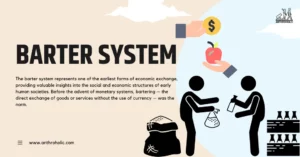AI Answer Evaluation Platform Live Now. Try Free Answer Evaluation Now
Ambilineal descent
Ambilineal descent, also termed as bilateral or cognatic descent, signifies a descent system in various cultures wherein an individual’s kinship and lineage are traced and determined through either the father’s or mother’s line. This anthropological concept does not rigidly subscribe to the more familiar matrilineal or patrilineal descent systems, thus offering an interesting perspective on human social organization and cultural norms [1].

Historical Overview
Historically, anthropologists have noted the existence of ambilineal descent in a number of societies across the world. These societies typically reside in regions with uncertain or unpredictable resource availability. The flexibility inherent in ambilineal systems allows them to adapt their societal affiliations based on resource allocation or socio-economic advantages, demonstrating a cultural response to environmental unpredictability (Sahlins, 1961).
Structural Characteristics of Ambilineal Descent
A defining characteristic of ambilineal descent systems is that they allow individuals the flexibility to determine their descent group—whether they choose to identify with their father’s or mother’s lineage. This decision can be made multiple times throughout an individual’s life, and it usually depends on a variety of socio-economic factors.
Moreover, it’s crucial to note that in ambilineal societies, descent groups are often composed of individuals who do not all share a common ancestor. This flexibility creates a system wherein kinship ties and descent groups are relatively fluid, resulting in diverse and adaptable social structures.
Ambilineal Descent and Gender
Unlike strictly patrilineal or matrilineal societies, ambilineal societies tend to exhibit less gender bias. Since descent is traced through both genders, it places equal importance on male and female lines, offering a more balanced societal structure. This aspect also reinforces the flexibility of ambilineal societies, as the gender of the parent does not limit an individual’s choice.
Ambilineal Descent in Practice
The Maori of New Zealand illustrate the practice of ambilineal descent, we turn our attention to the Maori people of New Zealand. Traditionally, the Maori traced descent through both their father’s and mother’s lineages, a practice known as whakapapa. A person could choose to emphasize one lineage over the other, depending on social, political, or economic circumstances. For example, if a person’s father’s lineage provided better access to resources or status, they might choose to identify more strongly with that side. Alternatively, they might select their mother’s lineage if it offered better social connections or safety. In practice, this meant that whakapapa was flexible and subject to change based on individual needs and societal pressures.
The Kanak People of New Caledonia, native to New Caledonia, are another example of a society practicing ambilineal descent. Individuals can choose their affiliation to a clan either from their mother’s or father’s side, or even shift this affiliation during their lifetime. Such shifts are primarily driven by factors such as marriage, wealth, and status. For instance, if a man’s wife’s family is wealthier or has a higher status, he might choose to identify with their clan for increased social and economic benefits.
The Nayar community of Kerala, India, presents a fascinating example of the ambilineal system. In this community, women have the option of connecting their offspring to their brothers, which results in a mix of matrilineal and patrilineal descent systems where matrilineal property rights are observed, but children also maintain a strong bond with their biological fathers.
Traditionally, the Native Hawaiian people also utilized an ambilineal system. Known as ‘ohana, it recognizes kin through both blood and adoptive ties, acknowledging both paternal and maternal lines (Linnekin, 1985). Members of an ‘ohana can trace their ancestry to a common ancestor but can align with either the mother’s or father’s line depending on the social or economic advantages it might offer. This flexibility allows members to form alliances and relationships beyond their immediate ‘ohana, enhancing social cohesion and adaptability within the larger Hawaiian society. The ‘ohana system, in which descent is fluid and inclusive, has been instrumental in the survival and resilience of Hawaiian culture, despite significant historical changes and challenges.
Anthropological Relevance
The study of ambilineal descent offers insights into the inherent flexibility of human societies to adapt to environmental and social uncertainties. By investigating these flexible kinship structures, anthropologists can gain a deeper understanding of human adaptability and cultural diversity. Furthermore, it underscores the influence of socio-economic factors in determining societal norms and structures.
Conclusion
In sum, the study of ambilineal descent provides a fascinating glimpse into the adaptability of human social structures. It underscores the idea that societal norms and structures can be fluid and dynamic, capable of shifting in response to changing socio-economic landscapes.
FAQs about Ambilineal Descent
Suggested Articles
| What is Descent? | Principles & Types | Bilateral Descent |
| Matrilineal Descent | Double Descent | Patrilineal Descent |
| Descent Groups | Descent and Alliance | Unilineal Descent |
References
[1] Fox, R. (1967). Kinship and Marriage: An Anthropological Perspective. Cambridge University Press.
[2] Sahlins, M. D. (1961). The Segmentary Lineage: An Organization of Predatory Expansion. American Anthropologist, 63(2), 322–345. https://anthrosource.onlinelibrary.wiley.com/doi/abs/10.1525/aa.1961.63.2.02a00050




